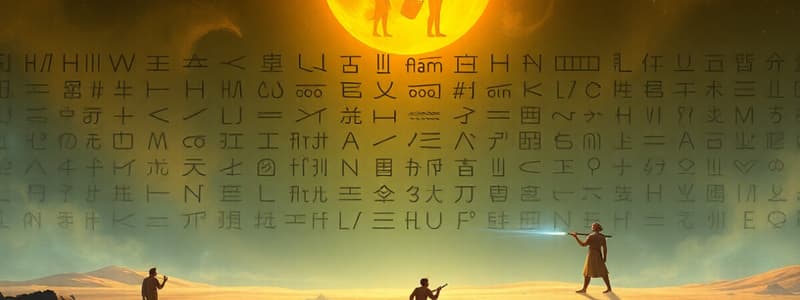Podcast
Questions and Answers
What was one of the main purposes of the Carolingian Minuscule?
What was one of the main purposes of the Carolingian Minuscule?
- To standardize script across Charlemagne's empire (correct)
- To create a script for decorative purposes
- To develop a new alphabet from scratch
- To combine all existing scripts into one
What characteristic distinguishes the Cursiva Romana Moderna from earlier writing styles?
What characteristic distinguishes the Cursiva Romana Moderna from earlier writing styles?
- It is written between four lines (correct)
- It employs elaborate decorations around letters
- It uses multiple colors in the ink
- It is written in a straight line without guidelines
Why was papyrus less durable than parchment?
Why was papyrus less durable than parchment?
- It was susceptible to humidity (correct)
- It could only be written on one side
- It was made using less quality materials
- It was more expensive to produce
What does the term 'quadrilinear scheme' refer to in Roman script evolution?
What does the term 'quadrilinear scheme' refer to in Roman script evolution?
What is a significant feature of Capitalis Quadrata?
What is a significant feature of Capitalis Quadrata?
Which of the following is a disadvantage of parchment compared to papyrus?
Which of the following is a disadvantage of parchment compared to papyrus?
What impact did the fall of Rome's Empire have on language and script?
What impact did the fall of Rome's Empire have on language and script?
What differentiates the serif font from sans serif?
What differentiates the serif font from sans serif?
What is the correct sequence of script evolution from a token?
What is the correct sequence of script evolution from a token?
Which of the following best describes the cuneiform writing system?
Which of the following best describes the cuneiform writing system?
Which statement about hieroglyphs is true?
Which statement about hieroglyphs is true?
What does 'acrophony' refer to in the context of alphabetic scripts?
What does 'acrophony' refer to in the context of alphabetic scripts?
What differentiates the Phoenician script from earlier writing systems?
What differentiates the Phoenician script from earlier writing systems?
How does the Greek alphabet differ from the Phoenician alphabet?
How does the Greek alphabet differ from the Phoenician alphabet?
What is a characteristic of the hieratic script in Ancient Egypt?
What is a characteristic of the hieratic script in Ancient Egypt?
Which statement accurately describes the process of script evolution?
Which statement accurately describes the process of script evolution?
Flashcards
Writing System
Writing System
A system of symbols used for writing, created by humans through the development of visual representations of words and sounds.
Pictogram
Pictogram
A simplified image of an object, representing the object itself. For example, drawing a sun to represent the sun.
Ideogram
Ideogram
A symbol representing a concept or idea, not necessarily a specific object. For example, a drawing of a hand holding a circle could represent 'ownership' or 'possession'.
Phonogram
Phonogram
Signup and view all the flashcards
Alphabetic Script
Alphabetic Script
Signup and view all the flashcards
Cuneiform Script
Cuneiform Script
Signup and view all the flashcards
Hieroglyphs
Hieroglyphs
Signup and view all the flashcards
Hieratic Script
Hieratic Script
Signup and view all the flashcards
Evolution of Latin Alphabet
Evolution of Latin Alphabet
Signup and view all the flashcards
Early Alphabet Development
Early Alphabet Development
Signup and view all the flashcards
Capitalis Quadrata
Capitalis Quadrata
Signup and view all the flashcards
Origin of Serif
Origin of Serif
Signup and view all the flashcards
Cursiva Romana Moderna
Cursiva Romana Moderna
Signup and view all the flashcards
Bilinear Scheme
Bilinear Scheme
Signup and view all the flashcards
Carolingian Minuscule
Carolingian Minuscule
Signup and view all the flashcards
Carolingian Script Rules
Carolingian Script Rules
Signup and view all the flashcards
Study Notes
Script Origins
- Scripts evolved from simple tokens to complex alphabets.
- Token: A small object representing something larger.
- Pictogram: A simplified image of an object.
- Ideogram: An image representing an idea or concept.
- Phonogram: An image representing a sound.
- Letter/Syllable: Words reduced to components represented by images.
Cuneiform Script
- Originated in Mesopotamia for commerce.
- Written with wedge-shaped strokes on clay tablets.
- Initially used for economic records, later expanded to religious and narrative texts.
Hieroglyphs
- Originated in Egypt, combining pictographs and symbols.
- Written in a linear, top-to-bottom order.
- Signs repeated with consistent sizing, regardless of proportions.
Hieratic and Demotic Scripts
- Hieratic: A cursive script using pen and ink on papyrus, developed alongside hieroglyphs.
- Demotic: A simplified version of hieratic and hieroglyphs intended to replace them.
Deciphering Scripts
- Rebus Principle: Combining images to represent a word based on similar pronunciation.
- Determinative: An ideogram indicating a word's semantic group.
Alphabet Evolution
- Proto-Sinaitic Script: Earliest alphabetic script; ancestor of several modern alphabets.
- Acrophony: Character names representing initial sounds.
- Phoenician Script: A true alphabet (only consonants) written right-to-left.
- Boustrophedon: Writing alternating between right-to-left and left-to-right directions, letters mirrored.
- Greek Alphabet: A true alphabet, introducing vowels.
- Etruscan Alphabet: Introduced word separation with vertical dots.
- Evolution of the Latin Alphabet: Direction changed to left-to-right, lost and invented letters, adopted spacing techniques.
Latin Alphabet Styles
- Capitalis Quadrata: Square capitals, modeled after the shape of the letter O.
- Origin of Serifs: Artistic additions during the preparatory stage for engraving.
- Cursiva Romana Moderna: A cursive style written between four lines with upward and downward extensions.
Papyrus vs Parchment
- Papyrus: Cheaper, widely distributed, susceptible to humidity.
- Parchment: More durable, both sides writable, but more expensive.
Early Christian Scripts
- Impact of Rome's Fall: Scripts diverged across regions.
- Carolingian Minuscule: A standardized script for Charlemagne's empire, based on Merovingian and uncial scripts, with specific rules for titles, headings, and body copy.
- Advantages of Carolingian Minuscule: Readability, easy writing, clear letter proportions.
Studying That Suits You
Use AI to generate personalized quizzes and flashcards to suit your learning preferences.




